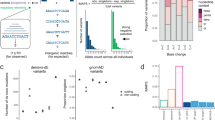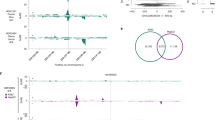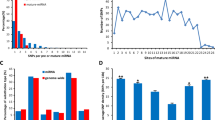Abstract
A fundamental problem in biology is understanding how natural selection has shaped the evolution of gene regulation. Here we use SNP genotype data and techniques from population genetics to study an entire layer of short, cis-regulatory sites in the human genome. MicroRNAs (miRNAs) are a class of small noncoding RNAs that post-transcriptionally repress mRNA through cis-regulatory sites in 3′ UTRs. We show that negative selection in humans is stronger on computationally predicted conserved miRNA binding sites than on other conserved sequence motifs in 3′ UTRs, thus providing independent support for the target prediction model and explicitly demonstrating the contribution of miRNAs to darwinian fitness. Our techniques extend to nonconserved miRNA binding sites, and we estimate that 30%–50% of these are functional when the mRNA and miRNA are endogenously coexpressed. As we show that polymorphisms in predicted miRNA binding sites are likely to be deleterious, they are candidates for causal variants of human disease. We believe that our approach can be extended to studying other classes of cis-regulatory sites.
This is a preview of subscription content, access via your institution
Access options
Subscribe to this journal
Receive 12 print issues and online access
$209.00 per year
only $17.42 per issue
Buy this article
- Purchase on Springer Link
- Instant access to full article PDF
Prices may be subject to local taxes which are calculated during checkout



Similar content being viewed by others
References
International HapMap Consortium. The International HapMap Project. Nature 426, 789–796 (2003).
Hinds, D.A. et al. Whole-genome patterns of common DNA variation in three human populations. Science 307, 1072–1079 (2005).
Rajewsky, N. microRNA target predictions in animals. Nat. Genet. 38, s8–13 (2006).
Bartel, D.P. MicroRNAs: genomics, biogenesis, mechanism and function. Cell 116, 281–297 (2004).
Abelson, J.F. et al. Sequence variants in SLITRK1 are associated with Tourette's syndrome. Science 310, 317–320 (2005).
Clop, A. et al. A mutation creating a potential illegitimate microRNA target site in the myostatin gene affects muscularity in sheep. Nat. Genet. 38, 813–818 (2006).
Fairbrother, W.G., Holste, D., Burge, C.B. & Sharp, P.A. Single nucleotide polymorphism-based validation of exonic splicing enhancers. PLoS Biol. 9, E268 (2004).
Drake, J.A. et al. Conserved noncoding sequences are selectively constrained and not mutation cold spots. Nat. Genet. 38, 223–227 (2006).
Hartl, D.L. A Primer of Population Genetics (Sinauer, Sunderland, Massachusetts, 2000).
Clark, A.G., Hubisz, M.J., Bustamante, C.D., Williamson, S.H. & Nielsen, R. Ascertainment bias in studies of human genome-wide polymorphism. Genome Res. 15, 1496–1502 (2005).
Akashi, H. Inferring the fitness effects of DNA mutations from polymorphism and divergence data: statistical power to detect directional selection under stationarity and free recombination. Genetics 151, 221–238 (1999).
Sabeti, P.C. et al. Positive natural selection in the human lineage. Science 312, 1614–1620 (2006).
McDonald, J.H. & Kreitman, M. Adaptive protein evolution at the Adh locus in Drosophila. Nature 351, 652–654 (1991).
Sawyer, S.A. & Hartl, D.L. Population genetics of polymorphism and divergence. Genetics 132, 1161–1176 (1992).
Stark, A., Brennecke, J., Bushati, N., Russell, R.B. & Cohen, S.M. Animal MicroRNAs confer robustness to gene expression and have a significant impact on 3′UTR evolution. Cell 123, 1133–1146 (2005).
Griffiths-Jones, S. et al. Rfam: annotating non-coding RNAs in complete genomes. Nucleic Acids Res. 33, D121–D124 (2005).
Farh, K.K. et al. The widespread impact of mammalian microRNAs on mRNA repression and evolution. Science 310, 1817–1821 (2005).
Krutzfeldt, J. et al. Silencing of microRNAs in vivo with 'antagomirs'. Nature 438, 685–689 (2005).
Giraldez, A.J. et al. Zebrafish MiR-430 promotes deadenylation and clearance of maternal mRNAs. Science 312, 75–79 (2006).
Allen, E. et al. Gigaxonin-controlled degradation of MAP1B light chain is critical to neuronal survival. Nature 438, 224–228 (2005).
Lu, R. et al. The fragile X protein controls microtubule-associated protein 1B translation and microtubule stability in brain neuron development. Proc. Natl. Acad. Sci. USA 101, 15201–15206 (2004).
Jin, P., Alisch, R.S. & Warren, S.T. RNA and microRNAs in fragile X mental retardation. Nat. Cell Biol. 6, 1048–1053 (2004).
Karolchik, D. et al. The UCSC Genome Browser Database. Nucleic Acids Res. 31, 51–54 (2003).
Gottwein, E., Cai, X. & Cullen, B.R. A novel assay for viral microRNA function identifies a single nucleotide polymorphism that affects Drosha processing. J. Virol. 80, 5321–5326 (2006).
Iwai, N. & Naraba, H. Polymorphisms in human pre-miRNAs. Biochem. Biophys. Res. Commun. 331, 1439–1444 (2005).
Krek, A. et al. Combinatorial microRNA target predictions. Nat. Genet. 37, 495–500 (2005).
Sood, P., Krek, A., Zavolan, M., Macino, G. & Rajewsky, N. Cell-type-specific signatures of microRNAs on target mRNA expression. Proc. Natl. Acad. Sci. USA 103, 2746–2751 (2006).
Su, A.I. et al. A gene atlas of the mouse and human protein-encoding transcriptomes. Proc. Natl. Acad. Sci. USA 101, 6062–6067 (2004).
Weir, B.S. & Cockerham, C.C. Estimating F-statistics for the analysis of population structure. Evolution 38, 1358–1370 (1984).
Rockman, M.V., Hahn, M.W., Soranzo, N., Zimprich, F. & Goldstein, D.B. Ancient and recent positive selection transformed opioid cis-regulation in humans. PLoS Biol. 3, e387 (2005).
Acknowledgements
We thank P. Andolfatto, R. Borowsky, E. Halperin, N. Hübner and M. Siegal for helpful discussions. We also thank E. van Nimwegen and R. Nielsen for critical readings of a preliminary version of the manuscript. This research was supported in part by the Howard Hughes Medical Institute grant through the Undergraduate Biological Sciences Education Program to New York University.
Author information
Authors and Affiliations
Corresponding author
Ethics declarations
Competing interests
The authors declare no competing financial interests.
Supplementary information
Supplementary Fig. 1
Derived allele frequency distributions of Perlegen SNPs in conserved miRNA sites. (PDF 171 kb)
Supplementary Fig. 2
Derived allele frequency distributions of Perlegen SNPs in coexpressed miRNA sites. (PDF 172 kb)
Supplementary Table 1
List of conserved miRNA sites. (XLS 2778 kb)
Supplementary Table 2
List of coexpressed miRNA sites. (XLS 1851 kb)
Supplementary Table 3
List of all SNPs used in the analysis. (XLS 157 kb)
Supplementary Table 4
microRNA expression data. (PDF 202 kb)
Rights and permissions
About this article
Cite this article
Chen, K., Rajewsky, N. Natural selection on human microRNA binding sites inferred from SNP data. Nat Genet 38, 1452–1456 (2006). https://doi.org/10.1038/ng1910
Received:
Accepted:
Published:
Issue Date:
DOI: https://doi.org/10.1038/ng1910
This article is cited by
-
Gene–environment interactions and their impact on human health
Genes & Immunity (2022)
-
A Study on microRNAs Targeting the Genes Overexpressed in Lung Cancer and their Codon Usage Patterns
Molecular Biotechnology (2022)
-
Comprehensive analysis of roles of atrial-fibrillation-related genes in lung adenocarcinoma using bioinformatic methods
Medical Oncology (2022)
-
DNRLCNN: A CNN Framework for Identifying MiRNA–Disease Associations Using Latent Feature Matrix Extraction with Positive Samples
Interdisciplinary Sciences: Computational Life Sciences (2022)
-
miR-6086 inhibits ovarian cancer angiogenesis by downregulating the OC2/VEGFA/EGFL6 axis
Cell Death & Disease (2020)



